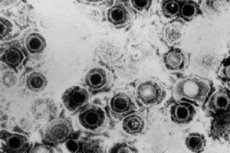
弗雷德·哈金森癌症研究中心的研究人员在临床前研究中发现,一种针对生殖器和口腔疱疹的实验性基因疗法可以消除90%或更多的感染,并抑制感染者排出的病毒数量。这表明该疗法或许也能减少病毒的传播。
“疱疹非常狡猾。它潜伏在神经细胞中,然后重新激活,导致皮肤出现疼痛的水疱,”弗雷德哈金森癌症研究中心疫苗和传染病学教授、医学博士基思·杰罗姆说道。“我们的目标是治愈这种感染,让他们不再生活在对疫情爆发或将病毒传染给他人的持续恐惧之中。”
杰罗姆和弗雷德哈金森癌症研究中心的团队开展的这项研究于 5 月 13 日发表在《自然通讯》杂志上,代表着朝着疱疹基因治疗迈出了令人鼓舞的一步。
这项实验性基因疗法需要将多种基因编辑分子混合物注入血液,以寻找疱疹病毒在体内的位置。混合物包括实验室改造的病毒(称为载体,常用于基因治疗)和充当分子剪刀的酶。一旦载体到达疱疹病毒藏匿的神经丛,分子剪刀就会剪断疱疹病毒基因,使其受损或完全清除病毒。
“我们使用一种大范围核酸酶,在两个不同的地方切割疱疹病毒的DNA,”弗雷德·哈金森癌症研究中心首席科学官、主要作者马丁·奥伯博士说道。“这些切割会严重损害病毒,使其无法自我修复。人体自身的修复系统会将受损的DNA识别为外来物质,并将其清除。”
使用小鼠感染模型,该实验疗法在面部感染(也称为口腔疱疹)后消除了90%的1型单纯疱疹病毒(HSV-1),在生殖器感染后消除了97%的HSV-1。接受治疗的小鼠大约一个月后才显示出这种病毒减少的迹象,而且病毒的减少似乎随着时间的推移变得更加彻底。
此外,研究人员发现 HSV-1 基因疗法显著降低了病毒脱落的频率和数量。
弗雷德哈金森癌症研究中心的病毒学家马丁·奥伯博士和基思·杰罗姆博士正在进行实验室实验,以开发一种旨在治愈疱疹的基因疗法。杰罗姆说:“如果你与疱疹患者交谈,你会发现他们中的许多人担心自己的感染是否会传染给他人。我们的新研究表明,我们可以同时减少体内病毒的数量和病毒的脱落量。”
Fred Hutch 团队还简化了基因编辑疗法,使其更安全、更容易生产。在 2020 年的一项研究中,他们使用了三种载体和两种不同的巨核酸酶。而最新的研究仅使用了一种载体和一种巨核酸酶,可以在两个位置切割病毒的 DNA。
“我们简化的基因编辑方法能够有效清除疱疹病毒,并且对肝脏和神经的副作用更小,”杰罗姆说。“这表明这种疗法对人体更安全,而且由于成分更少,更容易生产。”
尽管弗雷德·哈金森癌症研究中心的科学家们对基因疗法在动物模型中取得的良好效果感到鼓舞,并渴望将他们的研究成果应用于人类治疗,但他们对临床试验所需的准备步骤也持谨慎态度。他们还指出,虽然目前的研究主要针对的是HSV-1感染,但他们正在努力调整基因编辑技术,使其能够针对HSV-2感染。
杰罗姆表示:“我们正在与众多合作伙伴合作,推进临床试验,以满足联邦监管要求,确保基因治疗的安全性和有效性。我们非常感谢那些疱疹治愈倡导者的支持,他们与我们有着共同的治愈疱疹感染的愿景。”
单纯疱疹病毒 (HSV) 是一种常见感染,一旦感染即可终生持续存在。目前的治疗方法只能抑制症状,而无法完全消除,例如出现疼痛的水疱。据世界卫生组织统计,约有 37 亿 50 岁以下人群(67%)感染 HSV-1,该病毒可导致口腔疱疹。全球约有 4.91 亿 15-49 岁人群(13%)感染 HSV-2,该病毒可导致生殖器疱疹。
疱疹会导致人类其他健康问题。HSV-2 会增加感染 HIV 的风险。其他研究也发现痴呆症与 HSV-1 有关。

